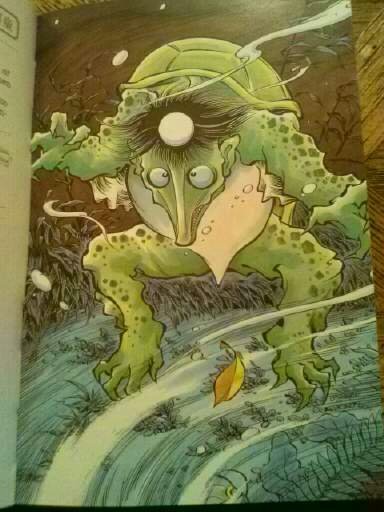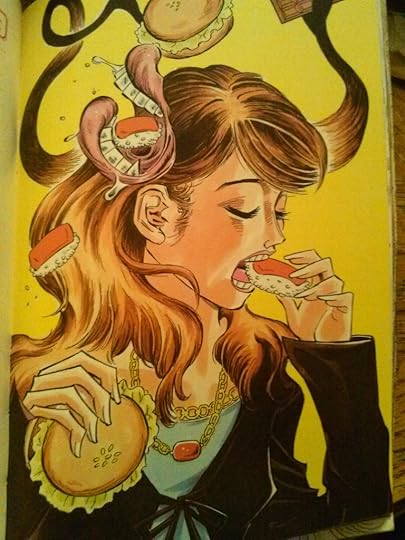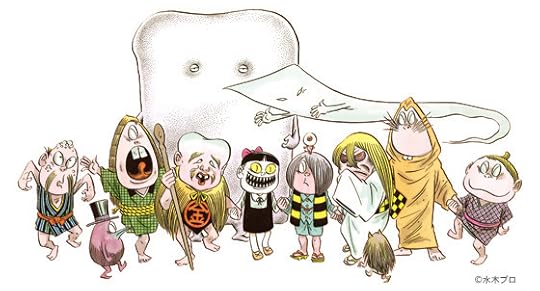What do you think?
Rate this book


211 pages, Kindle Edition
First published June 11, 2008



قالو قديماً بأن الإله إيزاناقي عندما عاد لأرض يومي حتى يطهر نفسه وليغتسل . وهو يتطهر سقطت قطرات ماء على التربة، التي أكسبت هذه البقعة صفات غريبة، ومنها ولد اليوكاي. - وجدت في أشعار الكويجي اليابانية، وهي أقدم نص ياباني معروف، حيث كُتب باللغة اليابنيه لكن بإستخدام الأحرف الصينية. Kojiki (古事記; Record of Ancient Matters) ويعود للقرن الثامن الميلادي.
هذه القصة المعروفه عن إيزانامي وإيزاناقي - رغم تعقيدها الشديد، وعدة معانيها المختلفة- تقدم لنا وصفاً فلكلورياً مبدئياً لأصل هذه الكائنات العجيبة. وتقدم لنا أيضاً نبذة للفلكلور الياباني المعقد جداً بمعانيه وتوسعه وانقسامه لإنقسام القبائل والمناطق التي آمنت بهذه الكائنات المخيفة العجيبة.
في القرن السابع الميلادي، كان من الشائع تسمية اليوكاي بـمونونوكي -mononoke- أو باكيمونو - bakemono - أي شبح للأولى، ووحش للثانية. التسمية تنوعت على مر الزمن حتى أصبح الوصف الدارج هو " يوكاي” yokai في هذا الزمن، وأصبح وصفاً دارجاً تقريباً لمعظم هذه الكائنات الغرائبية.
بالطبع من الصعب أن نحدد الإسم الحقيقي أو المعنى الصحيح المركز لكلمة yokai، إذ أنها تعود بالمعنى لكل ماهو فوق طبيعي. وشمولها لمعظم المونونوكي والأوني يدل على تحولها إلى كلمة جامعة لهذا الجنس الغير بشري. وبالطبع أنا أستثني هُنا اليوري Yurei إذ إنها أشباح الموتى وما شابهها.
في عمل توراياما سيكين، 1776 تطرق إلى رسم العديد من اليوكاي، معظمهم كما أسلفت في تدوينتي السابقة ( تصوير الموكب الليلي للمئة شيطان .. Gazu Hyakki Yagyō – 画図百鬼夜行 ) كانت من وحي خياله ولغرض المتعه والإستهزاء بالوضع الإجتماعي السائد آنذاك.
في القرن الثامن عشر، تحول اليوكاي من قصص رعب مخيفة وترتعد لها الفرائص هلعاً إلى مادة غنية للفن والأدب. ففي بدايات عصر ميجي، وقبل أن تفتح اليابان أبوابها للعالم الخارجي، انتشرت موضة لعب الأطفال ببطاقات الكاروتا karuta وتسمى ب أوباكي كاروتا التي يرسم عليها صور اليوكاي. تمت مناقشة ( المسابقة الوطنية في لعبة الكاروتا ) في الأنمي المدرسي chihayafuru .
صفحة الكاروتا في ويكيبيديا: اضغط للإنتقال.
بعد الإنفتاح على الغرب وبروز التقدم العلمي والتقني الكبير الواضح جداً في الغرب وبين الشرق المتمسك بتراثه وأساطيره، خرج الفيلسوف والبروفيسور الجامعي د.إينريو إينوي DR.Enryo Inoue أو كما يعرف بدكتور اليوكاي أو دكتور الوحوش الذي كره تعلق أبناء جلدته بهذه الأساطير والخرافات التي تنافي كُل أساسيات العلم و تُهدد بتواجدها التطور المدني كما ظن، فألف كتابه الخاص لفرز اليوكاي بأسس علمية وهو yokaigaku أو yokai-ology أو - دراسة للوحوش study of monsters- الذي وبسخرية تامه أصبح مرجعاً للباحثين ولدارسي الفلكلور الياباني. حيث صُنفت هذه المخلوقات حسب أماكن عيشها، وأين تظهر عادة.

ولكن هذه الدراسة نفسها لم تشتهر بيوم وليله، فحين نفذت كان هوس اليابانيين باليوكاي والأعاجيب قد خفت نتيجة للإنبهار الثقافي والعلمي، ليعود لنا رجل متحمس في نهايات القرن الثامن عشر تحت اسم مستعار ياباني لينشر هذه الثقافة خارج اليابان ويفتح عيون الغرب على هذا النوع من الفلكلور الياباني، بالطبع أنا أقصد بهذا الكاتب lafcadio Hearn أو كما كان يطلق على نفسه في مؤلفاته Yakumo Koizumi. هذا الرجل عشق الميثيولوجيا اليابانية ونشر عدة كتب تتضمن هذا الموضوع بمساعدة زوجته اليابانية سيتسوكو منها: “ في اليابان الشبحية in ghostly Japan “ 1899 وأيضاً كوايدن Kwaidan 1903. هذه الكتب ألهمت الكثير من الدارسين الشباب فكونيو ياناقيتا Kunio Yanagita كمثال، ألف في كتابه” قصص تونو Tono Monogatari (遠野物語) قام بجمع عدة قصص فلكلورية وأخرى عن الأشباح من المناطق الشمالية في اليابان والتي أشتهرت كثيراً حال نشرها في عام 1912.

وفي عام 1960 أصدر الرسام المشهور Shigeru Mizuki سلسلة المانجا الشهيرة GeGeGe no Kitaro التي أقتبست معظم شخصياتها من القصص الفلكلورية والفن الكلاسيكي الياباني المأخوذة غالباً من عمل ياناقيتا.
لم يقتصر الإقتباس من اليوكاي وطبيعتهم الغريبه لكتاب المانجا فقط، فحتى هاروكي موراكامي استوحى شخصيته “ الرجل الخروف” في رواية A Wild sheep chase من اليوكاي المسمى ياميكورو Yamikuro الذي ترجم للإنجليزية بمسمى Infra-Nocturnal Kappa ( بحثت عنه بالإنترنت لكن كما يبدو لم أجد أي نتيجة مفيدة، بدلاً من ذلك سقطت من جديد في حفرة الفوكالويد xD ).
ولا ننسى بالتأكيد هاياو ميزاكي وأفلامه التي تكاد تعتمد على الفلكلور الشعبي الياباني في بنائها ( الأميرة مونونوكي، توتورو، بونيو، و أخيراً سبريتيد أواي ) والكثير من باقي أفلامه التي تحوي حملاً ثقيلاً من الفِكر الشعبي الأقرب لحكايات العجائز الجميلة مصحوبة بموهبة إخراجية عظيمة وأسلوب مميز لا يمكن نسيانه “ بالطبع أنا أحد أكبر المشجعين والعاشقين لهذا المخرج ولأستيديو جيبلي العظيم”.
